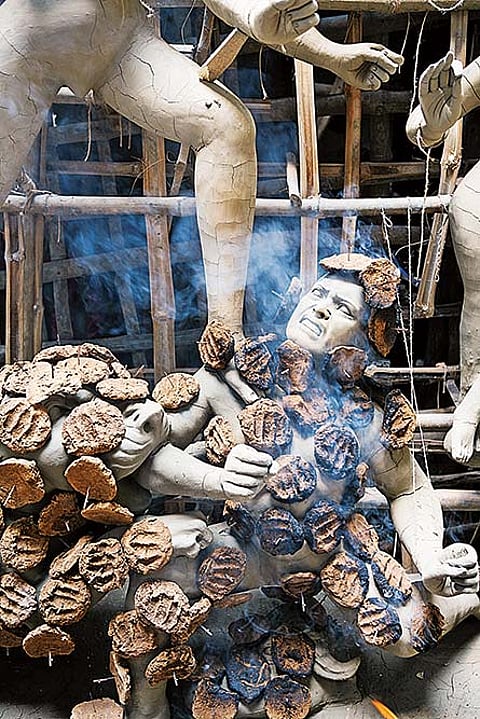As a child, Shantanu Pal (name changed), a potter in Calcutta’s Kumartuli, would be intrigued when his father, a reputed idol maker, would instruct his helper to get ready and leave in the dead of night. The helper would be back by early morning with mud wrapped in newspapers in a nylon bag, wash his hands and feet and change clothes. His father would then ask the helper if he had any trouble, and he would answer yes or no, giggling at his own narration of victory. This would usually happen at the beginning of monsoon, some 3-4 months before Durga Puja.
The Tradition Of Making Durga Idol With Soil From Sex Worker’s House
No festival is complete without its own set of myths. Traditions invented for the relatively new Durga Puja invoke a community society chooses to forget.
Growing up, Pal realised his father had pious intentions behind sending the helper at that hour to collect soil from outside the door of a sex-worker at Sonagachhi, Asia’s largest red-light area, to make his Durga idols.
Soil from outside the door of a sex worker is considered mandatory for making Durga idols, but sex workers have often resented the practice, and, according to some artisans of Kumartuli, the hub of idol making in Calcutta’s north, they often also demanded money for the soil. Hence the secrecy. Organisers of community pujas or well-to-do families hosting family pujas would, however, pay Rs 101 to the sex worker from outside whose home the soil was being taken.
Gone are those days. Shantanu has not sent any of his helpers in the past 10-15 years, as faith has given way to convenience. Like Shantanu, most other idol-makers now buy packaged soil.

Most artisans in Kumartuli are reluctant to talk about this, and almost never on record, as they fear this could harm their business. “Sex workers were never happy with the practice, as they resented the way they are usually treated by society. So, the collection usually happened at night. My father feared that not mixing soil from the prostitute’s doorstep would bring him misfortune. But we the younger generation are using packaged soil, just like devotees use packaged Gangajal instead of collecting it from the river,” says a renowned Kumartuli artisan who does not want to be identified.
Sex workers continue to highlight the practice when protesting injustices. In the beginning of October, with Durga Puja barely a week away, sex workers of Sonagachhi announced they would no longer allow puja organisers to take soil from outside their residences, to protest provisions of the draft anti-trafficking bill that they fear criminalises sex work. Quite likely, they thought this threat was potent enough to create an impact.
“If they don’t respect our existence in society, let us not be part of their festivals,” Kajol Basu, secretary of Durbar Mahila Samanyaya Committee (DMSC), India’s largest organisation of sex workers, had told the media.
The packaged soil sold in doshokarma bhandars—shops selling items for pujas and rituals—are branded doshomrittika, the ten soils, and sell for Rs 20 each. Doshomrittika is used in the worship of many gods. The mix is supposed to contain 10 types of soil, including soil taken from all four corners of a road crossing, both banks of the Ganges, from a bull’s horn, an elephant’s tusk, a boar’s tusk, a termite mound and a sex worker’s doorsteps.
Asked if he knew for sure if these packets of doshomrittika indeed contained soil from red-light areas, Anil Shaw, who owns a dashakarma bhandar at south Calcutta’s Kalighat—which, apart from being famous for the Kali temple, also houses a red-light area and a potua para, a hub of idol making—says, “How would I know? We buy it wholesale. And who is enquiring if it has soil taken from bull’s horns? It’s all about faith.”
According to Nrisingha Prasad Bhaduri, a scholar of ancient religious texts and retired professor of Jadavpur University, the practice does not date back beyond the 18th century. “There is no reference of this practice in religious scriptures. It possibly developed in the 18th century, when Durga Puja started emerging as a major festival in this part of India,” Bhaduri says.
He thinks the practice developed in order to accommodate every segment of society, especially with the belief that all women represented goddesses, something that has been mentioned in the religious text Chandimangal, and that the worship of the devi would remain incomplete if any woman were left out. “Durga is everyone’s mother. Bengalis also treat her as a daughter. So, I think the practice evolved to accommodate women from all walks of life.”
Durga Puja emerged as a major festival when families that grew wealthy under the East India Company, embraced it, starting with Maharaja Krishnachandra Ray of Nadia. Later, with the emergence of barowari (group of 12 eminences) and sarbajanin (community) pujas between the 18th and 19th centuries, this has continued till date.
Sex workers, however, contest the arguments. “A couple of years ago, police were denying permission to a puja sex workers wanted to organise. Eventually, the permission came from the high court. So they decided to allow collection of the soil only for their own pujas,” says Mahashweta Mukherjee, a spokesperson for DMSC.
(This appeared in the print edition as "Fallen Earth and Divine Soil")
ALSO READ
By Snigdhendu Bhattacharya in Calcutta